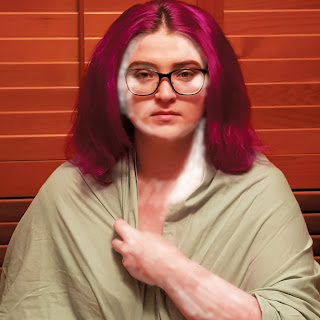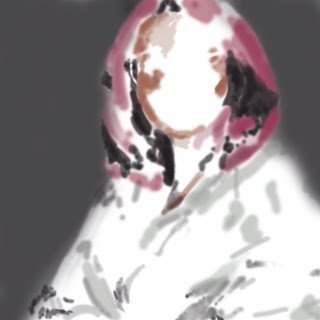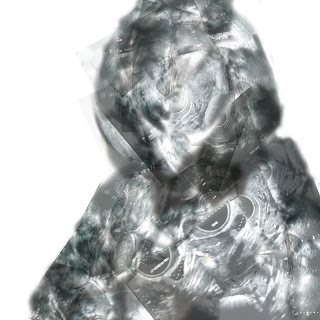https://www.christianthompson.net/
Wednesday, August 23, 2017
Christian Thompson
Tuesday, August 22, 2017
Monday, August 21, 2017
Sunday, August 20, 2017
Self Portraits #1
I now realise the previous sizes of A4 was a mistake since moving on to the use of light boxes. Their size is 29.5 x 29.5cms so the A4 size doesn't work. I had to re-collage all the images again and split them up into layers so that I can print them on separate sheets. They will then be displayed on top of each other.
The following posts will show the final composites of each image and the separate images that make them.
Final composite:
The following posts will show the final composites of each image and the separate images that make them.
Final composite:
Saturday, August 19, 2017
Xrays
I am interested in using medical imaging within my work, it is the basis of my collages already, but I also like the idea of displaying the work upon light boxes that mimic the viewing of xrays. As if placing it in that context tells the viewer to view it through a new language. For years I have been sent off for various tests, images and surgeries only to be brought back for results to my doctor. It is as if the medical imaging provided them with a new language with which to view me in. Until these results appeared they did not understand my issues or believe they exist. This new digital (medical imaging) language was the only thing they understood.
"Nowadays, artists use X-ray technologies directly in the conception and making of their work,
and as part of that art work, create shadow worlds that surprise the onlooker and solicit the
steady appearance of reality: matter is no longer solid, permanent and opaque but becomes
transparent, dissolves, multiplies and spectralises under the radiographic gaze. A shadow world
of a ghostly appearance reaches out beyond the object’s surface and person’s skin and
problematizes the discrete separation of inside and outside, Self and Other, the creative artist’s
body and the body of art created. What could be conceived of as the aura of the authentic,
indivisible Self is haunted by an Other shadow that questions the Self´s coherence and cohesion,
and affects artist and art, subject and object, agent and patient, blurring their discreteness. Walter
Benjamin saw the “aura” as that unique, singular quality of historical and temporal locatedness in
its making that gives the work of art its authenticity, as opposed to the mechanised vilification of
art in mass reproduction."
http://www.transformationsjournal.org/wp-content/uploads/2016/12/Fell_Transformations26.pdf
Through the collaging of my own ultrasound imagery, I have managed to create a medical imprint of my own body. A ghostly shadow that has been created through the use of these technologies. It is almost as if this other ghostly body has been created over the years and now exists within me, an imprint of the original, the mark that has been left behind.
David Maisel, History’s Shadow
Maisel continues, pointing out that the x-raying of objects has "historically been used for the structural examination of art and artifacts much as physicians examine bones and internal organs; it reveals losses, replacements, methods of construction, and internal trauma that may not be visible to the naked eye. The resulting prints of History's Shadow make the invisible visible, and express through photographic means the shape-shifting nature of time itself, and the continuous presence of the past contained within us."
https://www.gizmodo.com.au/2014/04/using-x-rays-to-peer-inside-ancient-art-objects/
Wednesday, August 9, 2017
Ultrasound
This is the ultrasound scan I have been using for my digital collages. I've had to photograph it in front of a light box because it needs light behind it for the scans to be visible. When I collage them together, the opacity of each layer is slightly different so the layers become transparent to form one complete image.
Tuesday, August 8, 2017
Printing #1
My first printing experiment at Live Image did not go so well. I printed the portrait on a glossy film instead of clear, and the ultrasound scans were printed on blacklit film instead of the clear too. So I cut up the scans and had a play with the light box. Seeing if the transparency on them would work, if I could maybe collage them once they were printed, rather than collaging them in Photoshop and then printing them.
These are the images I had printed. I was under the impression that they had to fit to a certain A4/A3 etc size. I now realise Live Image can print to a specific size, so the next ones will be printed at 29.5 cm x 29.5 cm. The same size as the light boxes.
Monday, August 7, 2017
Self Portrait Tests
A series of tests to start I started to make collages with. I created them at A4 size. These experiments were really just a play around with collaging techniques. Most of the collages were covering just the figure but I also toyed with the idea of covering the whole image. I liked the idea of my figure being transformed into the images, highlighting and shadowing the portrait with the ultrasounds in certain areas.
Friday, August 4, 2017
Marie Ellis Drawing Prize
Tonight was the opening for the Marie Ellis Drawing Prize opening night. I really enjoyed seeing the Brisbane drawing art scene in this competition. One of my favourite drawings from the night was this portrait by Travis D. Hendrix. It is beautifully drawn and really spoke to me in the room.
Thursday, August 3, 2017
Project Proposal
Through
portraiture, drawing and digital media, this project investigates self and
medicalised-imaging. By disrupting tropes of Renaissance portraiture and
associated conventions, my project will use classic poses from self-portraits, appropriating
the works of Albrecht Durer. I will rupture them through collage, medical
imaging, photography and hand and digital drawing. Each self-portrait will be a
layered work displayed on top of a light box. By doing this in layers, it
brings our attention to the invisible illness made visible as a parallel to the
x-ray and ultrasounds.
In
my previous project I created a large-scale hand drawn self-portrait that
merged ultrasound images with a digital collage of myself. I will be continuing
with self-portraits but in a different way. I will be borrowing some ideas from
history, particularly from the Renaissance; poses, ideals, soft colour palette
etc.
Albrecht Durer’s self-portraits have been the biggest
influence on my work. I studied Renaissance art last semester and became
fascinated with Durer’s portraits. I have chosen to appropriate poses from his
famous self-portraits. These portraits are from various stages of his life and
they uphold the classical ideals of portraiture from the Renaissance. By
mimicking these poses I seek to follow in his footsteps.
Through
reading the book The Self-Portrait, A
Cultural History; I have begun to understand the history of portraiture and
why self-portraits are so fascinating to me. I
am drawn to the medium of self-portraiture as a direct enquiry and reflection
into identity. From James Hall; “Durer used self-portraiture to
immortalize himself as the northern ‘artist-as-beauty’” (Pg. 81). The
Renaissance portraits are heroic portraits, they represent the classical ideals
of nobility and beauty. I aspire to present myself in a similar way.
However,
the re-invention of the
image is a means to find new pathways to discuss the
effects of medicalisation, hoping to enable a
dialogue which re-inserts the self back into the world, in a constructed and playful
manner. I aim to present myself as a survivor,
of someone worthy of being in a portrait.
In
each of these portraits Durer is dressed opulently with his hair a prominent
feature. Careful planning went into each aspect of the portrait. I have attempted
something similar, through my costuming. The green outfit represents a medical
gown, similar to the ones worn into surgery, while the other poses are my usual
clothing but presented in a classical way.
Other
artistic influences include, Raphael
who created some interesting portraits of women. They follow similar
portraiture conventions to Durer and have beautiful colour palettes. These
portraits were of particular women who could afford to have their portrait
painted. They were also carefully constructed and filled with symbolism.
Theodore Gericault’s “Portraits of the Insane” series is fascinating.
Usually classical portraits are commissioned by high ranking nobles and the
rich as they can be quite expensive. Here, Gericault has flipped the genre of
portraiture and included mentally unstable people, people that usually cannot
afford to have their portrait painted, people that are outcasts in society.
In
today’s society, there are still stigmas surrounding mental illness and chronic
illness. As visual beings, we question that if we cannot see it, then does it
really exist? In considering my personal illnesses as invisible, the internal
experience is hidden but the external physical experience is what everyone
sees.
This
project explores my everyday lived experience, investigating the effects of
medicalisation upon the human body and identity. The interference from
surgeries, medical examinations, and medical imaging. This is still traveling
on the ideas that Petherbridge talks about.
The action of drawing and trace as mark, interrogating notions of
visibility questioning whether there is any trace of the original left
behind.
In
my experiments, so far, I have created reference photographs and started
drawing these poses in a similar style to Durer.
Going
forward, methods I will use include; digital manipulation, printed collage, drawing
in layers using different classic materials (including charcoal, ink,
watercolour), and drawing upon them digitally.
I
will then present them in a small series upon lightboxes. These lightboxes
mimic the same set up when viewing x-rays. The white light behind the image
makes viewing layers possible, the same as x-rays and medical imaging enables
us to see what is inside our bodies.
Through
the collision of this with old classical portraits, I am referencing the
clinical aspect of medical imaging and the beginnings of my own personal
experience of medicalisation as a young woman.
Looking
to contemporary artists, Godwin Bradbeer
and Gillian Lambert are strong
influences.
Lambert creates grotesque portraits of disembodied
heads. The disembodied head is something that continues to pop up in
portraiture and self-portraiture. The importance of our identity is placed upon
our head. Here, Lambert uses similar materials to me and only focuses on the
head.
Bradbeer creates gorgeous large-scale portraits and full
body works in pastel. His figures are isolated and still as he explores the
imperfections of the human figure. The composition of each work is similar to
those seen in classical portraiture, his portraits feature the ¾ view and the
disembodied head. Bradbeer investigates “the body as a manifestation of the
human condition.”
In
talking about his own work: “My existential
conception separates the flawed struggle of rendered figuration from the
impossibly perfected surfaces of commercial digital culture and in doing so
seeks to find a testament to the enigmatic nature of our flawed human beauty.
As a figurative artist who developed in my art with a constant endeavor after
visual acuity, it is deeply ironic that in the twenty first century it should
be the flaw, the error, the struggle for verisimilitude that identifies such
drawings as works of experience”.
I
am interested in potentially merging android or cyborg motifs together with
these self-portraits. This stems from my interest in animes/films such as Ghost in the Shell and Ex Machina. An
investigation into the search to continually make ourselves better, altering
the physical body to achieve certain goals parallels the impact surgeries have upon
our health when we are unwell. I find it interesting that Bradbeer’s diptych
uses a similar pose to the one in Ghost in the Shell.
Tuesday, August 1, 2017
Drawings
After creating the photographs with the poses, I decided to draw the poses in the same style as Durer.
I like how they look layered over the original image on top of the light box. The light underneath helps view the images.
Subscribe to:
Comments (Atom)







































